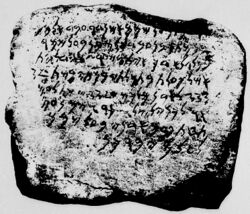Social:Baalshamin inscription
The Baalshamin inscription is a Phoenician inscription discovered in 1860–61 at Umm al-Amad, Lebanon, the longest of three inscriptions found there during Ernest Renan's Mission de Phénicie.[1] All three inscriptions were found on the north side of the hill;[2] this inscription was found in the foundation of one of the ruined houses covering the hill.[1]
The inscription is on an alabaster slab about 32 x 29cm. The writing is not deeply engraved and is not considered to be of monumental character; it was found almost intact except for the beginning, consisting of eight letters, which scholars were able to reconstruct partly from the traces present and partly from the content of the inscription.[1]
The inscription is known as CIS I 7. Today it is on display at the Louvre, with ID number AO 4831.[3]
The inscription
The Phoenician inscription reads (from right to left;[n 1] characters inside brackets denote a filled in lacuna):
| 𐤋𐤀𐤃𐤍𐤋𐤁𐤏𐤋𐤔𐤌𐤌𐤀𐤔𐤍𐤃𐤓𐤏𐤁𐤃𐤀𐤋𐤌 |
| 𐤁𐤍𐤌𐤕𐤍𐤁𐤍𐤏𐤁𐤃𐤀𐤋𐤌𐤁𐤍𐤁𐤏𐤋𐤔𐤌𐤓 |
| 𐤁𐤐𐤋𐤍𐤋𐤀𐤃𐤊𐤀𐤉𐤕𐤄𐤔𐤏𐤓𐤆𐤅𐤄𐤃𐤋𐤄𐤕 |
| 𐤀𐤔𐤋𐤐𐤏𐤋𐤕𐤁𐤕𐤊𐤋𐤕𐤉𐤁𐤍𐤕𐤉𐤁𐤔𐤕𐤙𐤘 |
| 𐤘𐤘𐤘𐤋𐤀𐤃𐤍𐤌𐤋𐤊𐤌𐤙𐤘𐤘𐤖𐤖𐤖𐤔𐤕𐤋𐤏𐤌 |
| 𐤑𐤓𐤋𐤊𐤍𐤉𐤋𐤉𐤋𐤎𐤊𐤓𐤅𐤔𐤌𐤍𐤏𐤌 |
| 𐤕𐤇𐤕𐤐𐤏𐤌𐤀𐤃𐤍𐤉𐤁𐤏𐤋𐤔𐤌𐤌 |
| 𐤋𐤏𐤋𐤌𐤉𐤁𐤓𐤊𐤍 |
Bibliography
- Editio Princeps: Renan, Ernest (1862). "Trois Inscriptions Phéniciennes Trouvées à Oum-El-Awamid" (in fr). Journal asiatique: Ou recueil de mémoires d'extraits et de notices relatifs à l'histoire, à la philosophie, aux sciences, à la littérature et aux langues des peuples orientaux (Société Asiatique) 20. https://books.google.com/books?id=RPs9AAAAcAAJ&pg=PA377.
- Renan, Ernest (1863). "Addition au mémoire de M. Renan sur les inscriptions d'Oum-el-Awamid" (in fr). Journal Asiatique (Société asiatique.) Nov. -Dec. 1863: 517. https://books.google.com/books?id=lV5FAQAAMAAJ&pg=RA2-PA517.
- Ledrain, Eugène, Notice sommaire des monuments phéniciens du Musée du Louvre, Musée du Louvre, Paris, Librairies des imprimeries réunies, 1888, p. 60, n° 126
- Clermont-Ganneau, C. (1895). "Nouvel essai d'interprétation de la première inscription phénicienne D’Oumm El-Awamid" (in fr). Études d'archéologie orientale. Bibl. de l'École des Hautes Études, Sci. philol. et hist. F. Vieweg. https://books.google.com/books?id=vZsWAAAAIAAJ&pg=PA37. Retrieved 2022-02-06.
- Bargès, J. J. L. (1863). "Observations sur les inscriptions phéniciennes du musée Napoléon III" (in fr). Journal Asiatique (Société asiatique.): 161–195. https://books.google.com/books?id=lV5FAQAAMAAJ&pg=RA1-PA161.
- Levy, M.A. (1864). "Drei inschriften von Umm-el-Awamid" (in de). Phönizische studien. Phönizische studien. F. E. C. Leuckart. p. 31-. https://books.google.com/books?id=K7tFAQAAIAAJ&pg=PA31.
Notes
- ↑ Unfortunately the rendered direction of the Phoenician text may vary across web browsers. See relevant talk page section.
References
- ↑ 1.0 1.1 1.2 Levy, 1864: "Die umfangreichste der drei Inschriften liest man auf einer Alabaster-Platte von ungefähr 32 Centimeter Länge und 29 Centimeter Breite. Der Stein wurde in dem Fundamente eines der verfallenen Häuser gefunden, welche den Hügel bedecken. Die Schrift ist nicht tief eingegraben und hat keinen monumentalen Charakter. Der Stein ist fast unversehrt, bis auf den Anfang, aus acht Buchstaben bestehend, der sich theils durch die vorhandenen Spuren, theils durch den Inhalt der Inschrift wieder herstellen lässt."
- ↑ Renan, 1862, “Ces trois inscriptions ont été trouvées sous terre, sur le côté nord du mamelon surmonté de colonnes ioniques et couvert de ruines qu'on appelle Oumm el-Awamid'. Les originaux sont déposés au musée Napoléon III.”
- ↑ AO 4830


